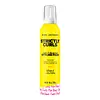What's inside
What's inside
 Key Ingredients
Key Ingredients

 Benefits
Benefits

 Concerns
Concerns

 Ingredients Side-by-side
Ingredients Side-by-side

Water
Skin ConditioningButane
Isobutane
Vp/Va Copolymer
Polyquaternium-11
Propane
Panthenol
Skin ConditioningCitrus Reticulata Peel Oil
MaskingCitrus Aurantium Dulcis Peel Oil
MaskingPEG-12 Dimethicone
Skin ConditioningLaureth-4
EmulsifyingPolysorbate 80
EmulsifyingEthylhexyl Methoxycinnamate
UV AbsorberBHT
AntioxidantPhenoxyethanol
PreservativeEthylhexylglycerin
Skin ConditioningSodium Benzoate
MaskingCitric Acid
BufferingParfum
MaskingBenzyl Benzoate
AntimicrobialLimonene
PerfumingWater, Butane, Isobutane, Vp/Va Copolymer, Polyquaternium-11, Propane, Panthenol, Citrus Reticulata Peel Oil, Citrus Aurantium Dulcis Peel Oil, PEG-12 Dimethicone, Laureth-4, Polysorbate 80, Ethylhexyl Methoxycinnamate, BHT, Phenoxyethanol, Ethylhexylglycerin, Sodium Benzoate, Citric Acid, Parfum, Benzyl Benzoate, Limonene
Water
Skin ConditioningIsobutane
Acrylates Copolymer
Propane
Polyquaternium-11
Tocopheryl Acetate
AntioxidantPanthenol
Skin ConditioningAloe Barbadensis Leaf Juice
Skin ConditioningHydrolyzed Silk
HumectantDisodium EDTA
Aminomethyl Propanol
BufferingButane
Sodium Chloride
MaskingHydroxyethyl Cetyldimonium Phosphate
PPG-10 Methyl Glucose Ether
Skin ConditioningCeteareth-25
CleansingBenzophenone-4
UV AbsorberParfum
MaskingPropylene Glycol
HumectantIodopropynyl Butylcarbamate
PreservativeDiazolidinyl Urea
PreservativeLimonene
PerfumingHexyl Cinnamal
PerfumingBenzyl Benzoate
AntimicrobialCitral
PerfumingLinalool
PerfumingWater, Isobutane, Acrylates Copolymer, Propane, Polyquaternium-11, Tocopheryl Acetate, Panthenol, Aloe Barbadensis Leaf Juice, Hydrolyzed Silk, Disodium EDTA, Aminomethyl Propanol, Butane, Sodium Chloride, Hydroxyethyl Cetyldimonium Phosphate, PPG-10 Methyl Glucose Ether, Ceteareth-25, Benzophenone-4, Parfum, Propylene Glycol, Iodopropynyl Butylcarbamate, Diazolidinyl Urea, Limonene, Hexyl Cinnamal, Benzyl Benzoate, Citral, Linalool
Ingredients Explained
These ingredients are found in both products.
Ingredients higher up in an ingredient list are typically present in a larger amount.
Benzyl Benzoate is usually created from the condensation of benzoic acid and benzyl alcohol. It is used as a preservative, solvent, and has a floral/balsamic scent in large amounts.
As a preservative, Benzyl Benzoate works against bacteria and fungus. It is often used to treat scabies and lice in medicine.
Solvents are used to keep ingredients together in a product. They can help dissolve ingredients to stable bases or help evenly distribute ingredients throughout the product.
Due to its fragrance, Benzyl Benzoate can be sensitizing and may cause contact dermatitis. It is a known EU allergen. We recommend speaking with a professional if you have any concerns.
Benzyl Benzoate can be naturally found in cranberries and peaches.
Learn more about Benzyl BenzoateButane is a gas derived from petroleum and natural gas. It is used as an aerosol propellant.
We don't have a description for Isobutane yet.
Limonene is a fragrance that adds scent and taste to a formulation.
It's found in the peel oil of citrus fruits and other plants such as lavender and eucalyptus. The scent of limonene is generally described as "sweet citrus".
Limonene acts as an antioxidant, meaning it helps neutralize free radicals.
When exposed to air, oxidized limonene may sensitize the skin. Because of this, limonene is often avoided by people with sensitive skin.
The term 'fragrance' is not regulated in many countries. In many cases, it is up to the brand to define this term. For instance, many brands choose to label themselves as "fragrance-free" because they are not using synthetic fragrances. However, their products may still contain ingredients such as essential oils that are considered a fragrance.
Learn more about LimonenePanthenol is a common ingredient that helps hydrate and soothe the skin. It is found naturally in our skin and hair.
There are two forms of panthenol: D and L.
D-panthenol is also known as dexpanthenol. Most cosmetics use dexpanthenol or a mixture of D and L-panthenol.
Panthenol is famous due to its ability to go deeper into the skin's layers. Using this ingredient has numerous pros (and no cons):
Like hyaluronic acid, panthenol is a humectant. Humectants are able to bind and hold large amounts of water to keep skin hydrated.
This ingredient works well for wound healing. It works by increasing tissue in the wound and helps close open wounds.
Once oxidized, panthenol converts to pantothenic acid. Panthothenic acid is found in all living cells.
This ingredient is also referred to as pro-vitamin B5.
Learn more about PanthenolParfum is a catch-all term for an ingredient or more that is used to give a scent to products.
Also called "fragrance", this ingredient can be a blend of hundreds of chemicals or plant oils. This means every product with "fragrance" or "parfum" in the ingredients list is a different mixture.
For instance, Habanolide is a proprietary trade name for a specific aroma chemical. When used as a fragrance ingredient in cosmetics, most aroma chemicals fall under the broad labeling category of “FRAGRANCE” or “PARFUM” according to EU and US regulations.
The term 'parfum' or 'fragrance' is not regulated in many countries. In many cases, it is up to the brand to define this term.
For instance, many brands choose to label themselves as "fragrance-free" because they are not using synthetic fragrances. However, their products may still contain ingredients such as essential oils that are considered a fragrance by INCI standards.
One example is Calendula flower extract. Calendula is an essential oil that still imparts a scent or 'fragrance'.
Depending on the blend, the ingredients in the mixture can cause allergies and sensitivities on the skin. Some ingredients that are known EU allergens include linalool and citronellol.
Parfum can also be used to mask or cover an unpleasant scent.
The bottom line is: not all fragrances/parfum/ingredients are created equally. If you are worried about fragrances, we recommend taking a closer look at an ingredient. And of course, we always recommend speaking with a professional.
Learn more about ParfumWe don't have a description for Polyquaternium-11 yet.
Propane is a gas derived from petroleum and natural gas. It is used as a propellant.
This ingredient is most commonly used in shaving cream, hair products, and makeup.
Water. It's the most common cosmetic ingredient of all. You'll usually see it at the top of ingredient lists, meaning that it makes up the largest part of the product.
So why is it so popular? Water most often acts as a solvent - this means that it helps dissolve other ingredients into the formulation.
You'll also recognize water as that liquid we all need to stay alive. If you see this, drink a glass of water. Stay hydrated!
Learn more about Water